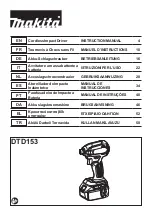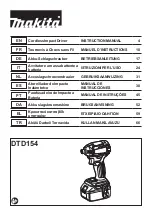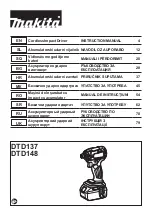
MT1734
2
Rev. 12/05/03
MT1734 3/8" Butterfly Impact Wrench
THIS INSTRUCTION MANUAL CONTAINS
IMPORTANT SAFETY INFORMATION.
READ THIS INSTRUCTION MANUAL CAREFULLY
AND UNDERSTAND ALL INFORMATION
BEFORE OPERATING THIS TOOL.
• Always operate, inspect and maintain this tool in
accordance with American National Standards
Institute Safety Code of Portable Air Tools (ANSI
B186.1) and any other applicable safety codes
and regulations.
• For safety, top performance and maximum durability
of parts, operate this tool at 90 psig 6.2 bar max
air pressure with 3/8" diameter air supply hose.
• Always wear impact-resistant eye and face
protection when operating or performing
maintenance on this tool.
• Always wear hearing protection when using this
tool. High sound levels can cause permanent hearing
loss. Use hearing protection as recommended by
your employer or OSHA regulation.
• Keep the tool in efficient operating condition.
• Operators and maintenance personnel must be
physically able to handle the bulk, weight and
power of this tool.
• Air powered tools can vibrate in use. Vibration,
repetitive motions or uncomfortable positions over
extended periods of time may be harmful to your
hands and arms. Discontinue use of tool if discomfort,
tingling feeling or pain occurs. Seek medical advice
before resuming use.
• Air under pressure can cause severe injury. Never
direct air at yourself or others. Always turn off the
air supply, drain hose of air pressure and detach tool
from air supply before installing, removing or
adjusting any accessory on this tool, or before
performing any maintenance on this tool. Failure to
do so could result in injury. Whip hoses can cause
serious injury. Always check for damaged, frayed
or loose hoses and fittings, and replace immediately.
Do not use quick detach couplings at tool. See
instructions for correct set-up.
• Place the tool on the work before starting the tool.
• Slipping, tripping and/or falling while operating air
tools can be a major cause of serious injury or
death. Be aware of excess hose left on the walking
or work surface.
• Keep body working stance balanced and firm. Do
not overreach when operating the tool.
• Anticipate and be alert for sudden changes in motion
during start up and operation of any power tool.
• Do not carry tool by the hose. Protect the hose from
sharp objects and heat.
• Tool shaft may continue to rotate briefly after throttle
is released. Avoid direct contact with accessories
during and after use. Gloves will reduce the risk of
cuts or burns.
•Keep away from rotating end of tool. Do not wear
jewelry or loose clothing. Secure long hair. Scalping
can occur if hair is not kept away from tool and
accessories. Choking can occur if neckwear is not
kept away from tool and accessories.
• Impact wrenches are not torque control devices
Fasteners with specific torque requirements must be
checked with suitable torque measuring devices
after installation with an impact wrench.
• Use only impact wrench sockets and accessories on
this tool. Do not use hand
• Do not lubricate tools with flammable or volatile
liquids such as kerosene, diesel or jet fuel.
• Do not force tool beyond its rated capacity.
• Do not remove any labels. Replace damaged labels.
FAILURE TO OBSERVE THESE WARNINGS COULD RESULT IN INJURY
OPERATION
The air regulator knob can be used as an air throttle, if there are
no other means of regulating air. Turn the air regulator knob all the
way to position 4 for maximum power.
The air regulator can be used to adjust torque to the approximate
tightness of a known fastener.To set the tool to desired torque, select
a nut or screw of known tightness of the same size, thread pitch
and thread condition as those on the job. Turn air regulator to low
position, apply wrench to nut and gradually increase power (turn
regulator to admit more air) until nut moves slightly in the direction
it was originally set. The tool is now set to duplicate that tightness -
note regulator setting for future use. When tightening nuts not
requiring critical torque values, run nut up flush and then tighten an
additional one-quarter to one-half turn (slight additional turning is
necessary if gaskets are being clamped). For additional power
needed on disassembly work, turn regulator to its fully open
position. This impact wrench is rated at 3/8" USS bolt size. Rating
must be down graded for spring U bolts, tie bolts, long cap screws,
double depth nuts, badly rusted conditions and spring fasteners as
they absorb much of the impact power. When possible, clamp or
wedge the bolt to prevent springback.
Soak rusted nuts in penetrating oil and break rust seal before
removing with impact wrench. If nut does not start to move in three
to five seconds use a larger size impact wrench. Do not use impact
wrench beyond rated capacity as this will drastically reduce tool
life.
The reversing valve is used to change the rotation of the tool. When
the valve is out, the tool is in a forward or right hand rotation.
When the valve is pushed in, the rotation is reverse or left hand.
NOTE: Actual torque on a fastener is directly related to joint
hardness, tool speed, condition of socket and the time the tool is
allowed to impact.
Use the simplest possible tool-to-socket hook up. Every connection
absorbs energy and reduces power.






















